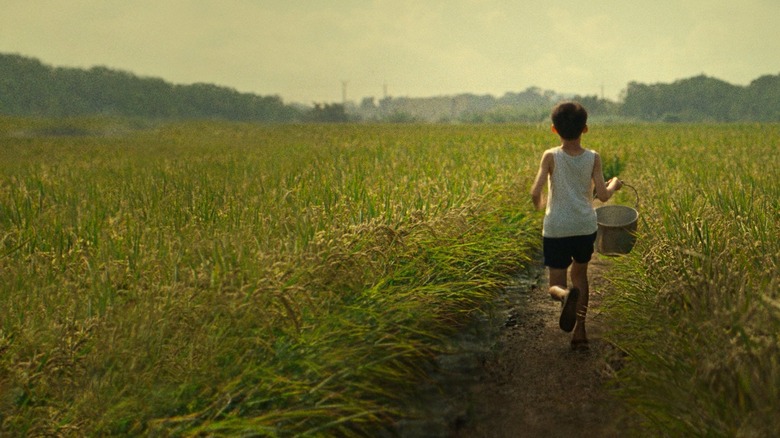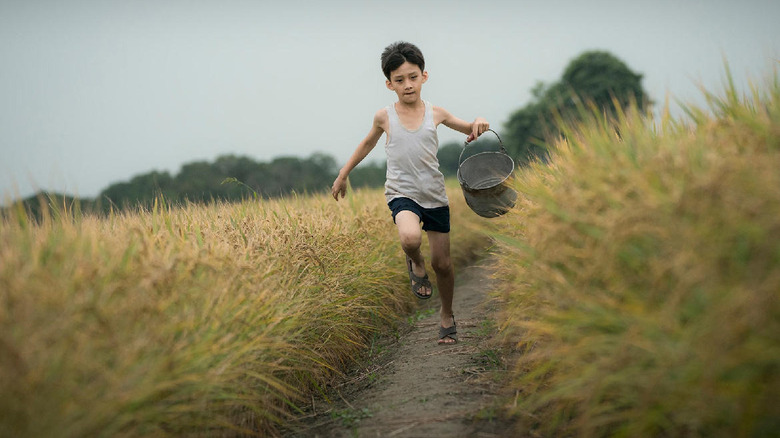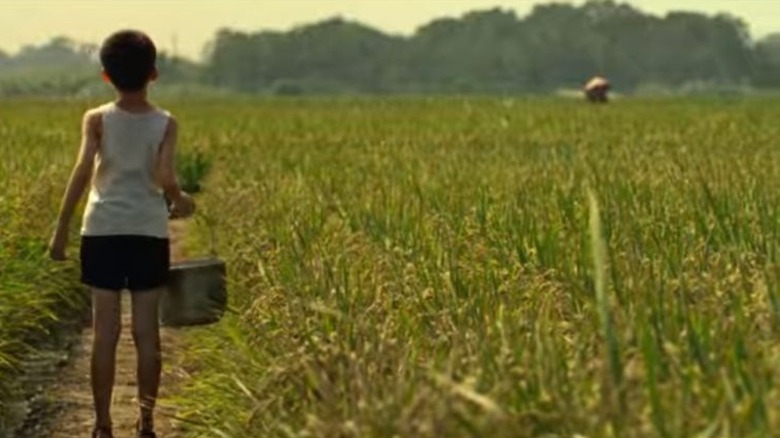Tigertail's Production Was Skirting Disaster From Its Very First Scene
Actor Tzi Ma is a person you've likely seen before. For decades, Ma carved out a career as a supporting player, often playing professors and doctors on TV and in film. He's appeared on nearly every high-ranked series that aired between 1988 and 2015 and recent movie fans may recognize Ma as General Shang in Denis Villeneuve's "Arrival" or the dad in Lulu Wang's "The Farewell."
Alan Yang's 2020 film "Tigertail" was a wonderful chance for Ma to star as the lead in a major studio production in the United States. Yang, in his directorial debut, wrote and directed a down-to-Earth story of a young man named Pin-Jui (Hong Chi-Lee when young, Ma when older) from Huwei, Taiwan, and details his experience growing up, meeting and dutifully marrying his wife (Kunjue Li, then Fiona Fu), leaving behind his true love, emigrating to the United States, and eventually hardening into a strict, business-minded father to an exasperated daughter (Christine Ko). It is a story of frustration and empathy. Tzi Ma gives a career-best performance.
Yang, a longtime TV writer who co-created "Master of None," seems to have modeled the characters at least partially on his own parents, who are about the same age as the characters in "Tigertail" and who are also from Huwei. "Tigertail" wasn't a wholly troubled production, but there were a few notable hiccups and aberrations. Perhaps most notably, actor John Cho was to appear in the film, but his scenes were ultimately cut. Also notable was the trouble Yang had in shooting the film's beautiful opening scene, seen in the picture above. Those scenes, as Yang describes in a 2020 interview with Fast Company, had to be shot on hastily-acquired cameras with short-focus lenses.
The 16mm saga
The opening shot of "Tigertail" depicts a boy running through a rice field in an image reminiscent of Terrence Malick. This scene seems to represent the verdant and lush life of a youth; a pleasant memory into which the Ma character could be rooted. Yang's location scout found just the right rice field in Taiwan, but it came with a caveat. Says Yang:
"He said, 'Just to let you know, these will be entirely yellow in a week. They'll all be yellow all around the country' ... "We scrambled. We didn't have our cameras from America."
The Fast Company article points out that, in order to capture the green rice field before it turned yellow for the season, Yang had to push up the film's shooting schedule by a month. The scrambling Yang refers to involved going to commercial and music video studios and assembling a crew, catch-as-catch can. He scooped up some 16mm film cameras, ran out to the field, and managed to get the shot he wanted. But, in Yang's words, the story doesn't end there. Although Yang had cameras and a crew, there was something wrong with the camera lenses: They were designed for shallow focus. That means they would only sharply photograph objects up to five feet away, leaving everything in the background blurry. Because they were shooting on film, Yang was unable to review the footage, and feared that what ended up in the can would not be useable.
"It was incredibly scary. I told my DP [Nigel Bluck] this has never happened on anything I've ever worked on. And he said likewise — in his 20-year career."
So, for safety's sake, the scene would need to be reshot, and they were still fighting against the timing of nature. Then the typhoon hit.
The typhoon
While Yang was trying to scramble a film crew — again — and pondering which roles would need to be recast just in case the old footage was unusable, a typhoon struck:
"They're telling me a typhoon's coming. This is all happening while we're shooting. We're doing these 16-hour days."
Yang had to hurry to shoot all the film's exteriors — still on whatever camera equipment he could salvage — and moved into a factory while the storm passed. While he was shooting indoors, the rice field footage was finally being reviewed back in the lab in New York. Yang revealed in the Fast Company interview that the issue was a scanning problem — that is, transferring the 16mm footage to a digital editing bay — and that was a problem that could be solved.
In order to figure out what needed to be re-shot and how much needed to be kept, Yang phoned up "Tigertail's" editor, Daniel Haworth, and asked for a favor:
"I said, 'I'm so sorry to do this to you — can you put on a pot of coffee and just edit the entire beginning of the movie to see what we have?"
Luckily for Yang, Haworth was game to put in the hard work, and assembled the film as Yang requested. And, what must have been quite a relief, about 90% of what Yang shot was acceptable and made its way into the final cut of the movie:
"I am the luckiest person in the world. All that footage was magical."
"Tigertail" is currently available on Netflix.


